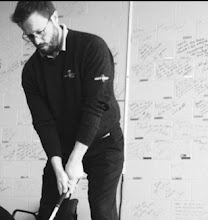For many slicing is a torment, which we try in vain to conquer. Some regard it as a virus, from which they suffer for years on end. No matter, how you describe a slice – it is sadly true that nearly 90% of all club players produce this type of curve all too regularly. Probably the reason why there are many more tips to cure the slice than any other problem shot.
WRONG
But why do we all still slice the ball still? In this article we will look at some of the aspects of the slice, some of which you may well have never heard. The title of this article is „Over the Top “. Which brings us neatly to the problem. This means that the golf club does not swing down parallel on the original plane line, rather in the downswing the club is further forward from the body (steeper shaft plane) resulting in the club coming from “out to in”. This swing path produces rotational spin on the ball allowing the ball to curve to the right in the air. The birth of the Slice! CORRECT

1 correct and wrong - do you recognize the difference? The most important position for all Slicer’s is halfway in the downswing. In the picture right Im showing the correct position of the club. In the next picture above you can see the problem of most Slicer’s - the club is clearly too far in front of the body with a too steep shaft plane. This swing path will cause a Slice or a Pull. Look carefully: Not only the golf club moves forward, but also the entire body loses the original angles during the swing. As most people always look at the movement of the club, and never the movement that the body is making, as this is important in the causing of a slice, which however hardly, if at all, once addressed.
Here are two exercises for you, in order to avoid going „Over the top “and improve your swing for the future:
1 Give your swing plane a chance Here I will show you, how it works: Place your golf bag or something similar (for instance take a chair and place the back of the chair) against your bum. During your swing your bum must stay in contact with the bag. So this maintains the hip angle and allows the club a chance to swing on the correct plane. 2. You can also place the palm of the right hand under the shaft in order to feel the way the club flattens.



































